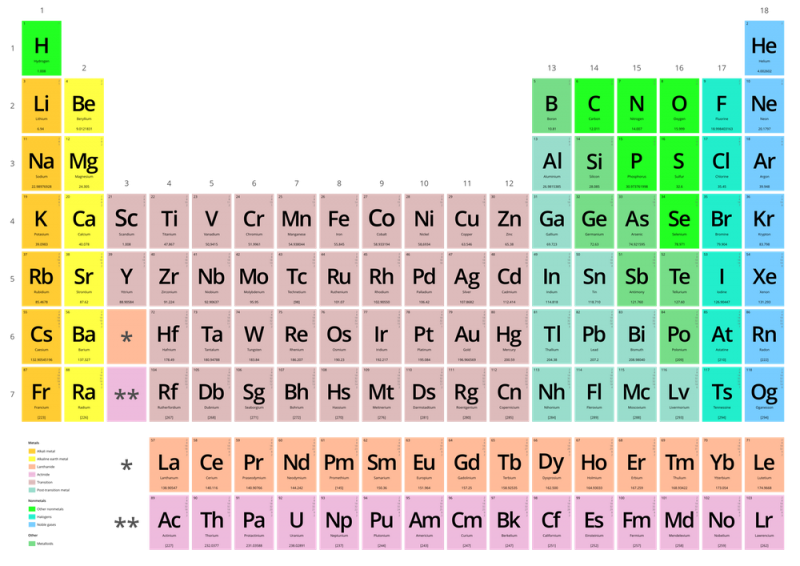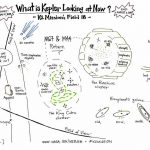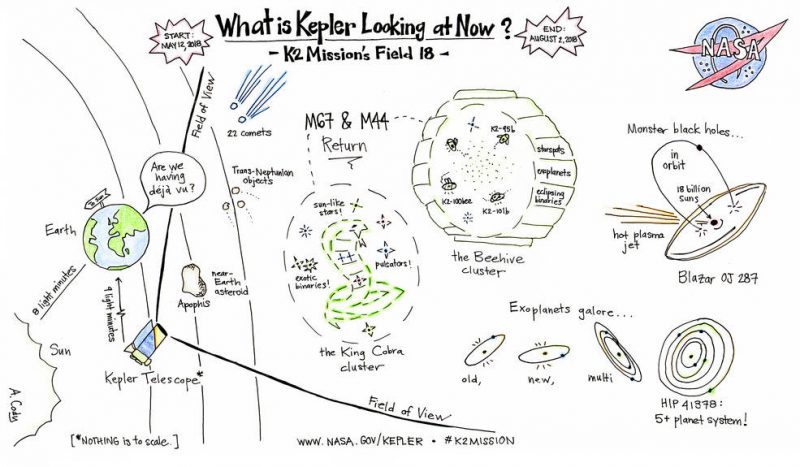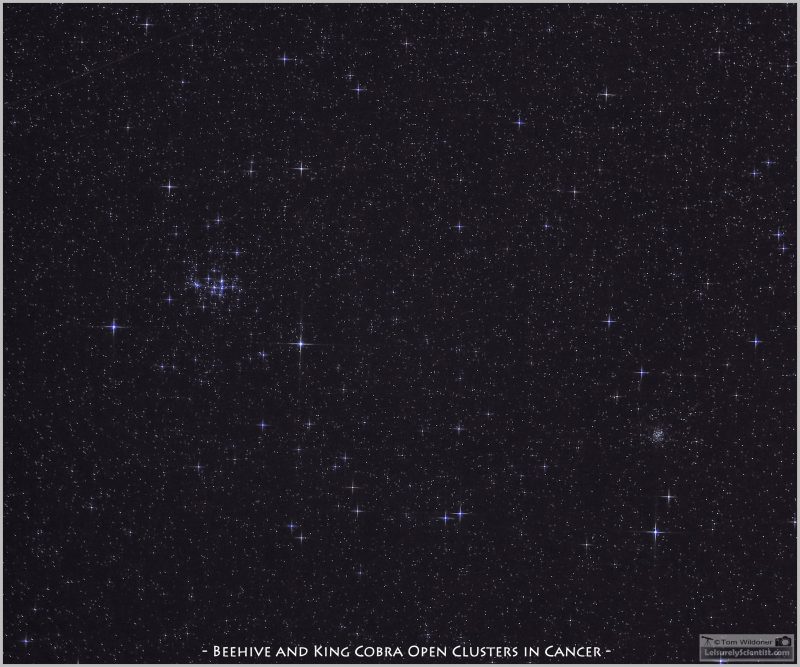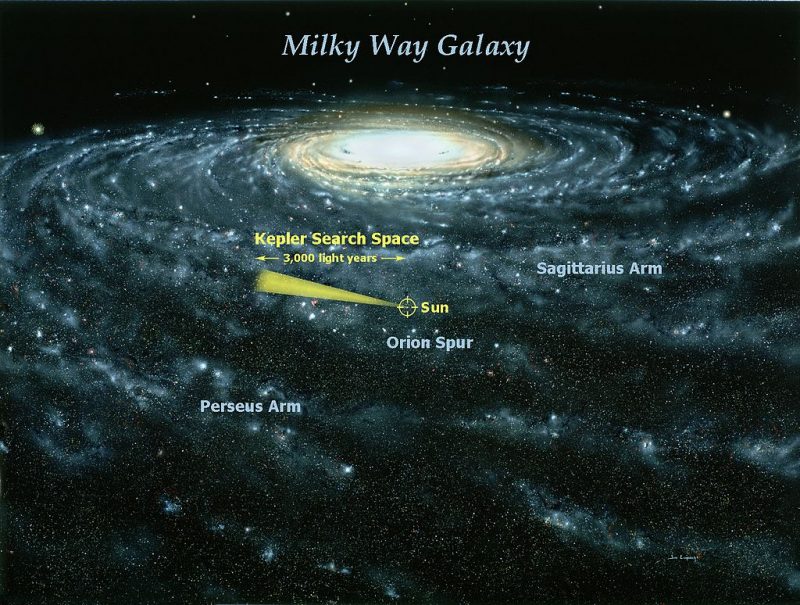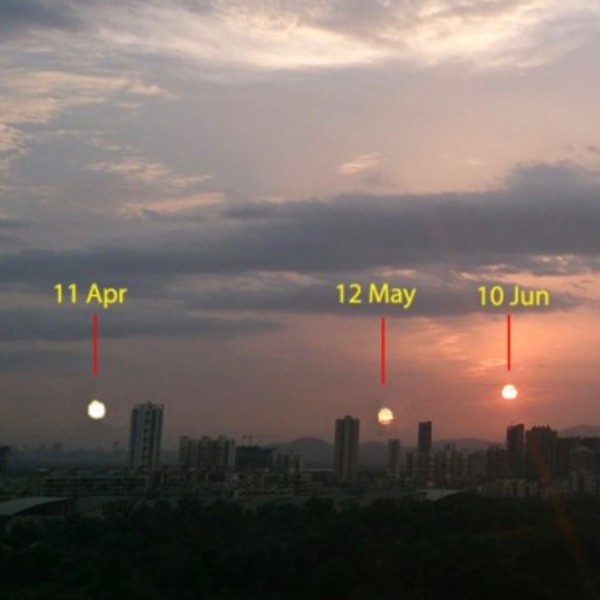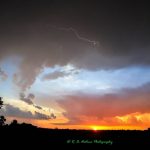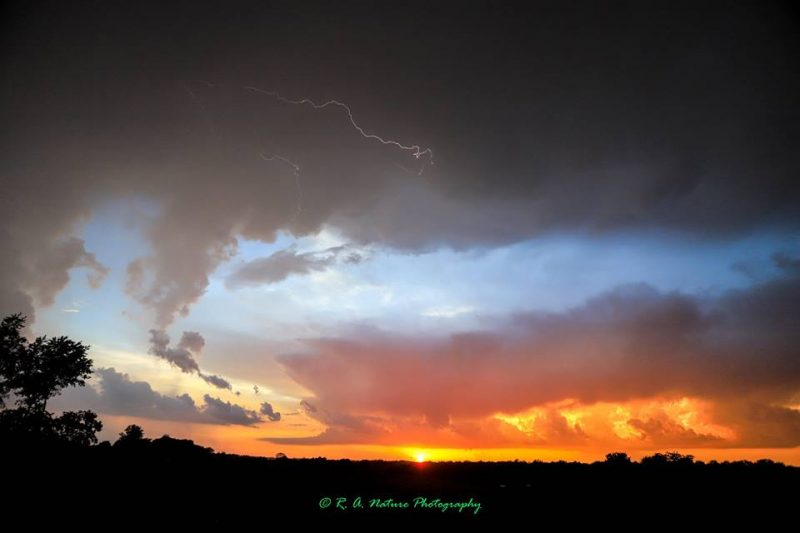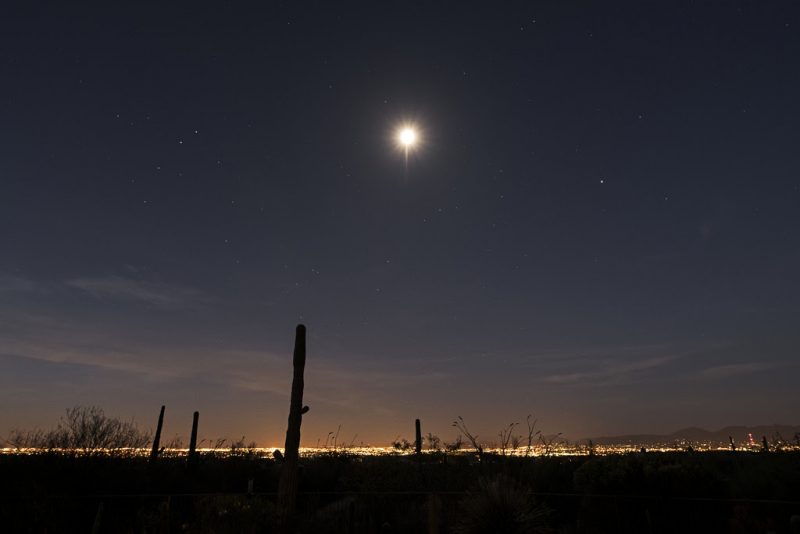
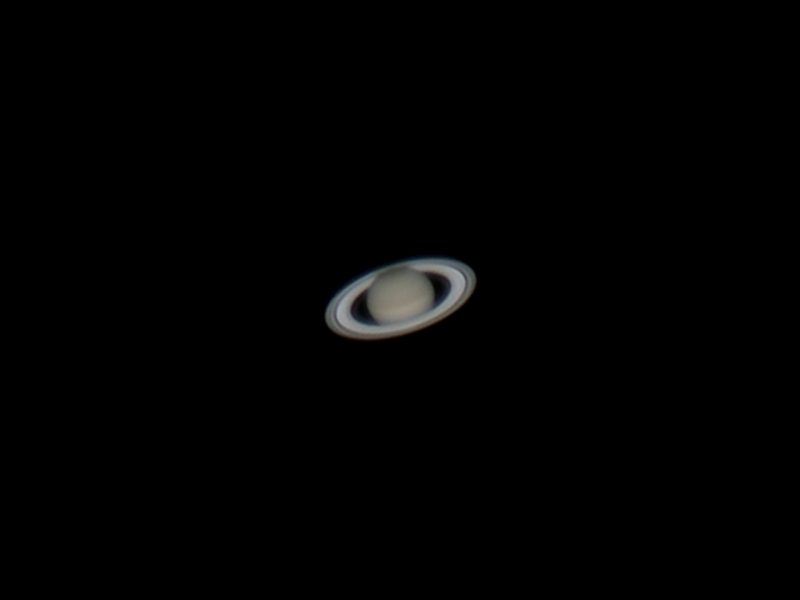
James Martin in Albuquerque, New Mexico, caught this wonderful photo of Saturn at last year’s opposition on June 15, 2017. Opposition marks the middle of the best time of year to see a planet. The 2018 opposition will happen on June 27.
It’s that magical time of year again, when the solar system’s favorite planet – Saturn – is well placed for viewing in our sky. Shining with a distinct golden color, Saturn is a lovely object to view with the eye alone. Binoculars will enhance its color … but to see Saturn’s rings you need a small telescope. And we do mean small. Veteran observer Alan MacRobert at SkyandTelescope.com has written:
The rings of Saturn should be visible in even the smallest telescope at 25x [magnified by 25 times]. A good 3-inch ‘scope at 50x [magnified by 50 times] can show them as a separate structure detached on all sides from the ball of the planet.
Help EarthSky keep going! Please donate what you can to our annual crowd-funding campaign.
You want to see Saturn’s rings. We know you do! Here are some basics:
1. Telescope. Don’t expect to see the rings in binoculars. You really do need a telescope. Don’t have one? Maybe there’s an astronomy club near you that will hold a star party in the near future. The links below might help you find one.
Astronomy Clubs Near Me & Organizations
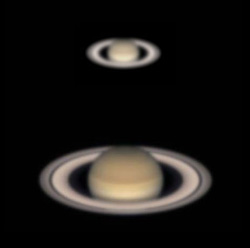
These images suggest how the ringed planet Saturn might look when seen through a telescope with an aperture 4 inches (100 mm) in diameter (top) and through a larger instrument with an 8-inch aperture (bottom). Image via SkyandTelescope.com/NASA/Hubble Space Telescope.
2. Tilt. The big night has come. You’re going to look through a telescope and see Saturn’s rings! Note the tilt of the rings. As with so much in space (and on Earth), the appearance of Saturn’s rings from Earth is cyclical. In 2017, the north side of the rings opened up most widely (27 degrees), as seen from Earth. That’s the most open this face of the rings has been since since 1988. In 2018, we’re past the peak of the north ring face opening, but Saturn’s rings are still inclined at about 26 degrees from edge-on, still exhibiting their northern face. By the year 2025, by the way, the rings will appear edge-on as seen from Earth. After that, we’ll begin to see the south side of Saturn’s rings and their openness will gradually increase to a maximum inclination of 27 degrees by May 2032.

The tilt of Saturn’s rings has a great impact on the planet’s overall brightness as seen from Earth. That’s why – although 2018’s opposition is distant – the planet isn’t particularly dim this year. In years when Saturn’s rings are edge-on as seen from Earth (2009 and 2025), Saturn does appear considerably dimmer than in years when Saturn’s rings are maximally tilted toward Earth (2017 and 2032). Image via Wikimedia Commons.
3. 3-D. Ask yourself … do Saturn’s rings look 3-dimensional? Again quoting Alan MacRobert at SkyandTelescope.com:
Saturn has a more three-dimensional appearance than any other object in the sky — at least that’s how it looks to me with a 6-inch scope on a night of fine seeing.
4. Seeing. What was Alan talking about in that quote above when he mentioned seeing? Both amateur and professional astronomers talk about the night’s seeing, which affects how clearly and sharply you can see a telescopic image. Seeing isn’t a quality of the telescope; it’s a quality of the air above you. It’s the reason the stars twinkle more on some nights than others. When the air is particularly turbulent, astronomers say there’s bad seeing. The images at the telescope shimmy and dance. When the air is particularly still, astronomers say there’s good seeing. Seeing can shift from moment to moment, as parcels of air move above you. So, as you’re gazing at Saturn, stand as quietly as you can – for as long as you can – and just look. You’ll notice moments when the image suddenly comes into sharper focus.
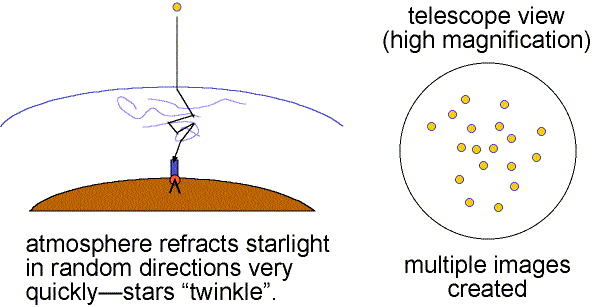
Turbulent air makes for poor seeing. But the air above you can also “settle” suddenly. When viewing Saturn, wait for those moments. Image via AstronomyNotes.com.
5. Other things to think about. Once you get comfortable viewing Saturn – assuming you’re able to view it again and again, with a telescope of your own – you’ll begin to notice details in the rings. Today, thanks to spacecraft, we know that Saturn’s rings are incredibly detailed. But, as you stand at your telescope gazing upward, you might be thrilled to witness just one primary division in the rings, the Cassini Division between the A and B rings, named for its French discoverer Jean D. Cassini. Seeing this dark division is a good test of the night’s seeing and your telescope’s optical quality, and also of your own eyes’ ability to simply look and notice what you see. By the way, if you’re looking at the rings – which means you’re viewing Saturn through a telescope – look also for one or more of Saturn’s many moons, most notably Titan.
Have fun!

Alas, you won’t see Saturn look like this through a telescope. This is a spacecraft view, from Cassini in 2016, showing Saturn’s northern hemisphere. Image via NASA/JPL-Caltech/Space Science Institute.
Bottom line: In 2018, Saturn’s opposition – marking the middle of the best time of year to see it – comes on June 27. Here are some tips for beginners, either those with new telescopes or those attending star parties, for things to look for and think about when you are planning to see Saturn’s rings.
Read more … Viewing Saturn: Rings, Planet and Moons
Help EarthSky keep going! Please donate what you can to our annual crowd-funding campaign.
from EarthSky https://ift.tt/2J50r7B


James Martin in Albuquerque, New Mexico, caught this wonderful photo of Saturn at last year’s opposition on June 15, 2017. Opposition marks the middle of the best time of year to see a planet. The 2018 opposition will happen on June 27.
It’s that magical time of year again, when the solar system’s favorite planet – Saturn – is well placed for viewing in our sky. Shining with a distinct golden color, Saturn is a lovely object to view with the eye alone. Binoculars will enhance its color … but to see Saturn’s rings you need a small telescope. And we do mean small. Veteran observer Alan MacRobert at SkyandTelescope.com has written:
The rings of Saturn should be visible in even the smallest telescope at 25x [magnified by 25 times]. A good 3-inch ‘scope at 50x [magnified by 50 times] can show them as a separate structure detached on all sides from the ball of the planet.
Help EarthSky keep going! Please donate what you can to our annual crowd-funding campaign.
You want to see Saturn’s rings. We know you do! Here are some basics:
1. Telescope. Don’t expect to see the rings in binoculars. You really do need a telescope. Don’t have one? Maybe there’s an astronomy club near you that will hold a star party in the near future. The links below might help you find one.
Astronomy Clubs Near Me & Organizations

These images suggest how the ringed planet Saturn might look when seen through a telescope with an aperture 4 inches (100 mm) in diameter (top) and through a larger instrument with an 8-inch aperture (bottom). Image via SkyandTelescope.com/NASA/Hubble Space Telescope.
2. Tilt. The big night has come. You’re going to look through a telescope and see Saturn’s rings! Note the tilt of the rings. As with so much in space (and on Earth), the appearance of Saturn’s rings from Earth is cyclical. In 2017, the north side of the rings opened up most widely (27 degrees), as seen from Earth. That’s the most open this face of the rings has been since since 1988. In 2018, we’re past the peak of the north ring face opening, but Saturn’s rings are still inclined at about 26 degrees from edge-on, still exhibiting their northern face. By the year 2025, by the way, the rings will appear edge-on as seen from Earth. After that, we’ll begin to see the south side of Saturn’s rings and their openness will gradually increase to a maximum inclination of 27 degrees by May 2032.

The tilt of Saturn’s rings has a great impact on the planet’s overall brightness as seen from Earth. That’s why – although 2018’s opposition is distant – the planet isn’t particularly dim this year. In years when Saturn’s rings are edge-on as seen from Earth (2009 and 2025), Saturn does appear considerably dimmer than in years when Saturn’s rings are maximally tilted toward Earth (2017 and 2032). Image via Wikimedia Commons.
3. 3-D. Ask yourself … do Saturn’s rings look 3-dimensional? Again quoting Alan MacRobert at SkyandTelescope.com:
Saturn has a more three-dimensional appearance than any other object in the sky — at least that’s how it looks to me with a 6-inch scope on a night of fine seeing.
4. Seeing. What was Alan talking about in that quote above when he mentioned seeing? Both amateur and professional astronomers talk about the night’s seeing, which affects how clearly and sharply you can see a telescopic image. Seeing isn’t a quality of the telescope; it’s a quality of the air above you. It’s the reason the stars twinkle more on some nights than others. When the air is particularly turbulent, astronomers say there’s bad seeing. The images at the telescope shimmy and dance. When the air is particularly still, astronomers say there’s good seeing. Seeing can shift from moment to moment, as parcels of air move above you. So, as you’re gazing at Saturn, stand as quietly as you can – for as long as you can – and just look. You’ll notice moments when the image suddenly comes into sharper focus.

Turbulent air makes for poor seeing. But the air above you can also “settle” suddenly. When viewing Saturn, wait for those moments. Image via AstronomyNotes.com.
5. Other things to think about. Once you get comfortable viewing Saturn – assuming you’re able to view it again and again, with a telescope of your own – you’ll begin to notice details in the rings. Today, thanks to spacecraft, we know that Saturn’s rings are incredibly detailed. But, as you stand at your telescope gazing upward, you might be thrilled to witness just one primary division in the rings, the Cassini Division between the A and B rings, named for its French discoverer Jean D. Cassini. Seeing this dark division is a good test of the night’s seeing and your telescope’s optical quality, and also of your own eyes’ ability to simply look and notice what you see. By the way, if you’re looking at the rings – which means you’re viewing Saturn through a telescope – look also for one or more of Saturn’s many moons, most notably Titan.
Have fun!

Alas, you won’t see Saturn look like this through a telescope. This is a spacecraft view, from Cassini in 2016, showing Saturn’s northern hemisphere. Image via NASA/JPL-Caltech/Space Science Institute.
Bottom line: In 2018, Saturn’s opposition – marking the middle of the best time of year to see it – comes on June 27. Here are some tips for beginners, either those with new telescopes or those attending star parties, for things to look for and think about when you are planning to see Saturn’s rings.
Read more … Viewing Saturn: Rings, Planet and Moons
Help EarthSky keep going! Please donate what you can to our annual crowd-funding campaign.
from EarthSky https://ift.tt/2J50r7B



